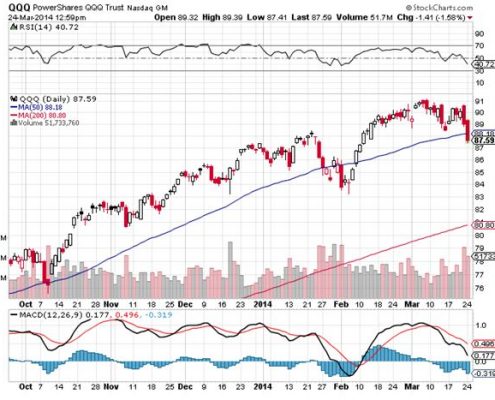
Global Market Comments
March 27, 2014
Fiat Lux
SPECIAL VOLATILITY ISSUE
Featured Trade:
(LAS VEGAS WEDNESDAY, MAY 14 GLOBAL STRAGEGY LUNCHEON),
(WILL CANDY CRUSH CRUSH THE MARKET?),
(SPY), (QQQ), (IWM), (KING), (VIX), (VXX),
(BUY FLOOD INSRANCE WITH THE (VXX), (VIX)
SPDR S&P 500 (SPY)
PowerShares QQQ (QQQ)
iShares Russell 2000 (IWM)
King Digital Entertainment Plc (KING)
VOLATILITY S&P 500 (^VIX)
iPath S&P 500 VIX ST Futures ETN (VXX)
Global Market Comments
March 26, 2014
Fiat Lux
Featured Trade:
(FRIDAY APRIL 25 SAN FRANCISCO STRATEGY LUNCHEON)
(THE AMERICAN ONSHORING TREND IS ACCELERATING),
(GE), (TSLA),
(TESTIMONIAL)
General Electric Company (GE)
Tesla Motors, Inc. (TSLA)
Global Market Comments
March 25, 2014
Fiat Lux
Featured Trade:
(FRIDAY APRIL 4 INCLINE VILLAGE, NEVADA STRATEGY),
(HEED THE MAD DAY TRADER?S Q2 FORECASTS),
(SPY), (QQQ), (IWM), (TLT), (TBT), (FXY),
(FXE), (FXA), (CU), (USO), (GLD), (GDX)
SPDR S&P 500 (SPY)
PowerShares QQQ (QQQ)
iShares Russell 2000 (IWM)
iShares 20+ Year Treasury Bond (TLT)
ProShares UltraShort 20+ Year Treasury (TBT)
CurrencyShares Japanese Yen Trust (FXY)
CurrencyShares Euro Trust (FXE)
CurrencyShares Australian Dollar Trust (FXA)
First Trust ISE Global Copper Index (CU)
United States Oil (USO)
SPDR Gold Shares (GLD)
Market Vectors Gold Miners ETF (GDX)
Mad Day Trader, Jim Parker, thinks that the next three to six months will be a tough time for the financial markets. They won?t crash, but won?t break out to new highs either.
Instead, they will stay confined to technically driven, narrow, low volume ranges that will cause traders to tear their hair out. It will be an environment where it will be tough for anyone to make money. The long only crowd will be particularly challenged. Better to take your summer vacation early this year, and make it a long one.
Jim uses a dozen proprietary short-term technical and momentum indicators to generate buy and sell signals, which he has developed over 40 years of trading in the Chicago futures markets. Last year Jim?s Trade Alerts generated returns for followers well into triple digits. He absolutely nailed the performance of every asset class this year in his Q1 Medium Term Outlook (click here for the link at http://madhedgefundradio.com/january-2-2014-mdt-medium-term-outlook-1st-qtr-2014/ . Ignore him at your peril.
Parker has been using NASDAQ (QQQ) as his lead contract for 2014. When it rolled over two weeks ago, it broke momentum across asset classes. Look no further than the biotech area, formerly the hottest in the market. It?s dramatic, sudden reversal, along with the losses seen in other speculative names, like Tesla (TSLA), Netflix (NFLX), and Herbalife (HLF), indicate that the easy money is gone.
The big confirming move for this cautious stance has been in the Treasury bond market (TLT). Its failure to break down has amazed many strategists. Instead of the ten-year bond yield exploding to a 3.05% yield as expected, it ran all the way down to 2.58%. This was the tell that the bull markets days were numbered. Bond prices are now threatening to break to new highs, taking yields to 2.50% or lower.
The other clue to the behavior of this years markets has been the Japanese yen. While the yen was plunging, stocks and other risk assets soared. That came to an abrupt halt on the last trading day of 2013. Notice that since then, the major stock indexes have not been able to hold on to any gains whatsoever.
This is because traders borrow, and then sell the Japanese currency, to fund any new positions. A flat lining yen means that risk taking has ceased, and that?s exactly what we have seen so far in 2014.
It won?t always be this bad. A long period digesting the meteoric gains of the past two and five years could be followed by a bang up fourth quarter, much like we saw in 2013. The key to success will be not to lose all your money before then.
Here is Jim?s Q2 forecast for each major asset class:
Stocks ? The leadership of NASDAQ is dead and buried for now. Don?t go back in until it closes above 3,745 and holds it. The same is true for the S&P 500 (SPX), which must surpass 1,880 to buy.
Bonds ? It?s alright to hold them here (TLT). If we break the years high at $109.60, it could race up to $114. At that point get out, as risk will be high.
Foreign Currencies - $139.50 has got to be the top in the Euro (FXE). As long as the yen (FXY) is comatose, he doesn?t want to touch it. You want to buy the Australia dollar (FXA) on a break above $91.50. Until then, it will remain trapped in an $88.50-$91.50 range.
Commodities ? The fireworks are over for now for oil. We need some digestion of the $15 move from $92 before we can revisit the upside. Hands off, until we break above $101.50. Copper (CU) is at the bottom of an extended range. You would be nuts to go short here, unless of course, we slice through $2.95.
Precious Metals ? Gold (GLD), (GDX) is toast. To see the sell off accelerate when geopolitical risk remains high has to be especially disheartening for the bulls. A retest of the $1,265 low, then $1,180 is in the cards. Unless you went short the barbarous relic the day it peaked last week, avoid.
Agricultural ? Jim called the bottom on this one (DBA), (CORN) at the New Year. Since then, the ags have raced to an intermediate high. The Crimea crisis gave it an added boost. His long side targets for soybeans (SOYB) have all been hit.? Nothing to do here, unless the weather suddenly turns bad.
While the Diary of a Mad Hedge Fund Trader and Global Trading Dispatch focus on investment over a one week to six-month time frame, Mad Day Trader will exploit moneymaking opportunities over a ten minute to three-day window. It is ideally suited for day traders, but can also be used by long-term investors to improve market timing for entry and exit points. During normal trading conditions, you should receive two to five market updates and Trade Alerts a day.
As with our existing service, you will receive ticker symbols, entry and exit points, targets, stop losses, and regular real time updates. At the end of each day, a separate short-term model portfolio will be posted on the website.
Jim is a 40-year veteran of the financial markets and has long made a living as an independent trader in the pits at the Chicago Mercantile Exchange. He has worked his way up from a junior floor runner, to advisor to some of the world?s largest hedge funds. We are lucky to have him on our team and gain access to his experience, knowledge, and expertise.
I have been following his alerts for the past five years, and his market timing has become an important part of the ?unfair advantage? that I provide readers.
A trading service with this degree of success and sophistication normally costs $20,000 a year. As a client of The Mad Hedge Fund Trader, you can purchase Mad Day Trader alone for $699 a quarter, or $2,000 a year. Or you can buy it as a package together with Global Trading Dispatch, which we call Mad Hedge Fund Trader PRO, for $4,000 a year, a 20% discount to the full retail price.
To learn more about The Mad Day Trader, please visit my website at http://madhedgefundradio.com/mad-day-trader-service/. To subscribe, please click here.
If you want to get a pro rata upgrade from your existing Newsletter or Global Trading Dispatch subscription to Mad Hedge Fund Trader Pro, which includes Mad Day Trader, just email Nancy in customer support at support@madhedgefundtrader.com.
 Ignore Him at Your Peril
Ignore Him at Your Peril
Global Market Comments
March 24, 2014
Fiat Lux
Featured Trade:
(MARCH 26 GLOBAL STRATEGY WEBINAR),
(READ OIL & ENERGY INSIDER FOR TRADING CLUES),
(USO), (UNG), (APC), (NBL)
(END OF THE COMMODITY SUPERCYCLE),
(SLV), (PPLT), (PALL), (CU), (BHP), (USO),
(CORN), (WEAT), (SOYB), (DBA), (RSX)
United States Oil (USO)
United States Natural Gas (UNG)
Anadarko Petroleum Corporation (APC)
Noble Energy, Inc. (NBL)
iShares Silver Trust (SLV)
ETFS Physical Platinum Shares (PPLT)
ETFS Physical Palladium Shares (PALL)
First Trust ISE Global Copper Index (CU)
BHP Billiton Limited (BHP)
Teucrium Corn (CORN)
Teucrium Wheat (WEAT)
Teucrium Soybean (SOYB)
PowerShares DB Agriculture (DBA)
Market Vectors Russia ETF (RSX)
I am often asked to divulge my research sources that give me my unfair advantage in trading. I usually decline such requests, unwilling to part with the ?secret sauce? that enables me to beat the market, as well as most other hedge fund managers year after year. Why level the playing field for my competitors, what few there are?
However, it would be greedy and selfish of me not to divulge one of my most important sources of red-hot information about the energy markets. That would be the newsletter, Oil & Energy Insider, published by my friend and comrade in arms in the online education business, Jim Stafford.
Jim has put together a crack team of analysts and writers and distills their collective wisdom into a daily publication sent out to paying subscribers. The talent includes my buddy, oil guru, Dan Dicker, Dave Forest and Martin Tiller.
Dicker made a fortune when his oil trading firm was bought out a few years ago, and now hangs around for the love of the trade, much as I do. He consults on trading strategies with major hedge funds and is a regular personality in the media. It hasn?t hurt that he has been dead right on the direction of oil for the past 15 years.
Dan is also a sector stock picker, although he thinks the energy sector is somewhat over stretched after a great run. His favorites to buy here are Anadarko (APC), which should bounce back hard after an outstanding lawsuit is resolved. Another is Noble Energy (NBL), which Dan believes has the best and most undervalued portfolio of assets in the energy space.
Dan is an oil bull, although not a peak oiler. Fracking, alternatives, and conservation are all great, but don?t change the reality that oil will be our major source of energy for the next 30 years.
As I never tire of pointing out to readers, nothing in the energy industry ever happens quickly. US shale oil is only contributing 2 million barrels a day out of global production of 91 million, and is growing slowly.
He doesn?t think that Texas tea will fall below $92 a barrel in the current economic environment. He thinks that the risk/reward of an oil short at $100/barrel is terrible. Only a financial crash could take it substantially below that, such as we had in 2008, when it hit $30.
However, the United States Oil Fund (USO) is another story. Because of the drag created by the contango, whereby far month oil futures contracts trade at huge premiums to front month ones, this ETF is almost guaranteed to go to zero.
It fact, the possibility is even disclosed in the prospectus. This is why short plays in the (USO) on top of an oil spike is one of my favorite in the entire financial arena.
The long term trend for oil is up, driven by ever expanding demand from Asia. He goes into depth on the issue in his 2011 book, Oil?s Endless Bid. Usually the impetus for an oil price spike is a geopolitical one that comes out of the blue.
This is why Oil & Energy Insider has tied up with the Washington political and country risks intelligence firms, Southern Pulse and ISA Intel, regular contributors to Stafford?s newsletter. These guys spend their days scrounging remote countries best known as a reliable source of venereal disease. Hey, better them than me.
The problem is that these are the same counties that regularly unleash flocks of vicious black swan on the financial markets, particularly those homing in on energy. Look no further than the recent crisis in the pipeline endowed Ukraine, which rose up out of nowhere to threaten a global economic recovery. Political instability in Nigeria is another ever-present threat to your energy supply. Ignore them at your peril. The list goes on.
To take a look at recent sample issues of Oil & Energy Insider, please click on the following:
http://oilprice.com/newsletters/premium/oei140314 and
http://oilprice.com/newsletters/premium/oei7314 .
To read a much more detailed description of the breadth of services offered by Oil & Energy and an opportunity to subscribe please click here: Oil & Energy Insider. At $497 a year it?s a real bargain. Better get a move on, because they are about to raise their price to $797, hence the urgency of this piece.
 Maybe This Will Affect Prices?
Maybe This Will Affect Prices?
Global Market Comments
March 21, 2014
Fiat Lux
Featured Trade:
(CHICAGO FRIDAY, MAY 23 GLOBAL STRAGEGY LUNCHEON)
(THE RECEPTION THAT THE STARS FELL UPON),
(NLR), (CCJ), (CORN), (WEAT), (SOYB), (DBA),
(THE MOST FUNCTIONAL WORD IN THE ENGLISH LANGUAGE)
Market Vectors Uranium+Nuclear Enrgy ETF (NLR)
Cameco Corporation (CCJ)
Teucrium Corn (CORN)
Teucrium Wheat (WEAT)
Teucrium Soybean (SOYB)
PowerShares DB Agriculture (DBA)
My friend was having a hard time finding someone to attend a reception who was knowledgeable about financial markets, White House intrigue, international politics, and nuclear weapons.
I asked who was coming. She said Reagan?s Treasury Secretary, George Shultz, Clinton?s Defense Secretary, William Perry, and Senate Armed Services Chairman, Sam Nunn. I said I?d be there wearing my darkest suit, cleanest shirt, and would be on my best behavior, to boot.
When I arrived at San Francisco?s Mark Hopkins Hotel, I was expecting the usual mob scene. I was shocked when I saw the three senior statesmen making small talk with their wives and a handful of others.
It was a rare opportunity to grill high-level officials on a range of top secret issues that I would have killed for during my days as a journalist for The Economist magazine. I guess arms control is not exactly a hot button issue these days. I moved in for the kill.
I have known George Shultz for decades, back when he was the CEO of the San Francisco based heavy engineering company, Bechtel Corp. I saluted him as ?Captain Schultz?, his WWII Marine Corp rank, which has been our inside joke for years. Since the Marine Corps didn?t know what to do with a PhD in economics from MIT, they put him in charge of an anti-aircraft unit in the South Pacific, as he already was familiar with ballistics, trajectories, and apogees.
I asked him why Reagan was so obsessed with Nicaragua, and if he really believed that if we didn?t fight them there, we would be fighting them in the streets of Los Angeles. He replied that the socialist regime had granted the Soviets bases for listening posts that would be used to monitor US West Coast military movements in exchange for free arms supplies. Closing those bases was the true motivation for the entire Nicaragua policy. To his credit, George was the only senior official to threaten resignation when he learned of the Iran-contra scandal.
I asked his reaction when he met Soviet premier Mikhail Gorbachev in Reykjavik in 1986 when he proposed total nuclear disarmament. Shultz said he knew the breakthrough was coming because the KGB analyzed a Reagan speech in which he had made just such a proposal.
Reagan had in fact pursued this as a lifetime goal, wanting to return the world to the pre nuclear age he knew in the 1930?s, although he never mentioned this in any election campaign. As a result of the Reykjavik Treaty, the number of nuclear warheads in the world has dropped from 70,000 to under 10,000. The Soviets then sold their excess plutonium to the US, which today generates 10% of the total US electric power generation.
Shultz argued that nuclear weapons were not all they were cracked up to be. Despite the US being armed to the teeth, they did nothing to stop the invasions of Korea, Hungary, Vietnam, Afghanistan, and Kuwait.
I had not met Bob Perry since the late nineties when I bumped into his delegation at Tokyo?s Okura Hotel during defense negotiations with the Japanese. He told me that the world was far closer to an accidental Armageddon than people realized.
Twice during his term as Defense Secretary he was awoken in the middle of the night by officers at the NORAD early warning system to be told that there were 200 nuclear missiles inbound from the Soviet Union. He was given five minutes to recommend to the president to launch a counterstrike. Four minutes later, they called back to tell him that there were no missiles, that it was just a computer glitch.
When the US bombed Belgrade in 1999, Russian president, Boris Yeltsin, in a drunken rage, ordered a full-scale nuclear alert, which would have triggered an immediate American counter response. Fortunately, his generals ignored him.
Perry said the only reason that Israel hadn?t attacked Iran yet, was because the US was making aggressive efforts to collapse the economy there with its oil embargo. Enlisting the aid of Russia and China was key, but difficult since Iran is a major weapons buyer from these two countries. His argument was that the economic shock that a serious crisis would bring would damage their economies more than any benefits they could hope to gain from their existing Iranian trade.
I told Perry that I doubted Iran had the depth of engineering talent needed to run a nuclear program of any substance. He said that aid from North Korea and past contributions from the AQ Khan network in Pakistan had helped them address this shortfall.
Ever in search of the profitable trade, I asked Perry if there was an opportunity in the nuclear plays, like the Market Vectors Uranium and Nuclear Energy ETF (NLR) and Cameco Corp. (CCJ) that have been severely beaten down by the Fukushima nuclear disaster. He said there definitely was. In fact, he personally was going to lead efforts to restart the moribund US nuclear industry. The key here is to promote 5th generation technology that uses small, modular designs, and alternative low risk fuels like thorium.
I had never met Senator Sam Nunn and had long been an antagonist, as he played a major role in ramping up the Vietnam War. Thanks to his efforts, the Air Force, at great expense, now has more C-130 Hercules transport planes that it could ever fly because they were assembled in his home state of Georgia. Still, I tried to be diplomatic.
Nunn believes that the most likely nuclear war will occur between India and Pakistan. Islamic terrorists are planning another attack on Mumbai. This time India will retaliate by invading Pakistan. The Pakistanis plan on wiping out this army by dropping an atomic bomb on their own territory, not expecting retaliation in kind. But India will escalate and go nuclear too. Over 100 million would die from the initial exchange. But when you add in unforeseen factors, like the broader environmental effects and crop failures (CORN), (WEAT), (SOYB), (DBA), that number could rise to 1-2 billion. This could happen as early as this year.
Nunn applauded current administration efforts to cripple the Iranian economy, which has caused their currency to fall 70% in the past six months. The strategy should be continued, even if innocents are hurt. He argued that further arms control talks with the Russians could be tough. They value these weapons more than we do, because that?s all they have left. Nunn delivered a stunner in telling me that Warren Buffet had contributed $50 million of his own money to enhance security at nuclear power plants in emerging markets. I hadn?t heard that.
As the event drew to a close, I returned to Secretary Shultz to grill him some more about the details of the Reykjavik conference held some 26 years ago. He responded with incredible detail about names, numbers, and negotiating postures. I then asked him how old he was. He said he was 92. I responded ?I want to be like you when I grow up?. He answered that I was ?a promising young man.? It was the best 62nd birthday gift I could have received.
 Oops, Wrong Number
Oops, Wrong Number
Global Market Comments
March 20, 2014
Fiat Lux
Featured Trade:
(ORLANDO FLORIDA SATURDAY, MAY 17 GLOBAL STRAGEGY LUNCHEON),
(MAKING HAY WITH THE EAGLEFORD SHALE),
(USO), (UNG), (XOM), (CVX), (LNG), (CHK), (HAL)
(THE PASSING OF A GREAT MAN)
United States Oil (USO)
United States Natural Gas (UNG)
Exxon Mobil Corporation (XOM)
Corporation (CVX)
Chevron Cheniere Energy, Inc. (LNG)
Chesapeake Energy Corporation (CHK)
Halliburton Company (HAL)
Global Market Comments
March 19, 2014
Fiat Lux
Featured Trade:
(LAS VEGAS WEDNESDAY, MAY 14 GLOBAL STRAGEGY LUNCHEON),
(THE MYSTERY OF THE MISSING $100 BILLION), (TLT),
(AN EVENING WITH CONGRESS BARNEY FRANK)
iShares 20+ Year Treasury Bond (TLT)


















